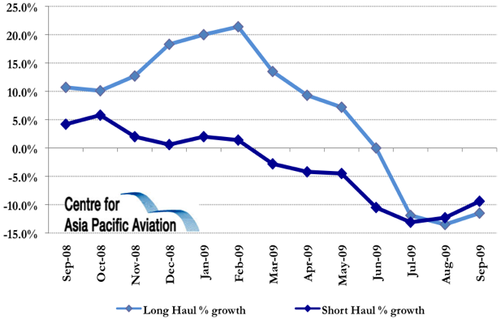Air New Zealand yields stabilise in Sep-2009, domestic fare restructuring announced
The rapid deterioration in Air New Zealand's yields over the past six months appears to have stabilised in Sep-2009, after bottoming out in Jul/Aug-2009, with Group yields down 8.6% in the month, following contractions of 11.0% and 11.3% in the previous two months. Yields, excluding exchange rate effects, fell 10.4% year-on-year last month, following reductions of 14.1% and 15.1% in Aug-2009 and Jul-2009, respectively. Is this the start of a recovery, or a pause in a downward spiral?
Air New Zealand Group yields including and excluding exchange rate effects (% change year-on-year): Sep-2008 to Sep-2009
Air New Zealand's long-haul yields continued to take a hammering last month falling 11.5%, following Aug-2009's 13.5% contraction. Short-haul yields remain under pressure following Jetstar's entry in the domestic market, falling 9.4% last month, although this is the first month of single-digit contractions since May-2009.
Air New Zealand short- vs long haul yields (% change year-on-year): Sep-2008 to Sep-2009
Load factors up for second consecutive month in Sep-2009
In more positive news, Air New Zealand's load factors were up in the month, gaining 4.5 ppts, as the carrier reduced capacity (ASKs) by 11.9%, for two consecutive months of load factor improvements. Prior to this, the carrier experienced a double blow of sharp yield contractions and declining load factors.
In Sep-2009, Air New Zealand transported 1.2 million passengers, a 1.2% reduction, as short-haul passenger numbers increased by 0.5% and long-haul passenger numbers fell 10.7% (although this was an improvement from the previous month's 16.4% reduction).
The carrier reduced capacity on Tasman/Pacific routes by 13.1%, primarily through downsizing to smaller aircraft and the withdrawal of trans-Tasman services from Hamilton and Dunedin.
The carrier also reduced capacity on Asia/Japan/UK routes by 18.1%, helping load factors to gain 2.3 ppts to 81.9%. Load factors on North America/UK routes also improved, up 2.8 ppts year-on-year, with demand down 7.3% on a 10.2% capacity contraction.
More yield pressure ahead, as unsustainable competition intensifies
Load factor improvements aside, intense yield pressures are expected to remain, as Air New Zealand continues to suffer from rising competition and global economic weakness.
Qantas/Jetstar continues its aggressive push on the Tasman and in domestic New Zealand markets, while Pacific Blue continues to fight to grow its presence domestically and internationally.
In response, Air New Zealand today unveiled moves to reduce its domestic fares by up to 23%, while also simplifying its fare structures.
Regional services, where Air NZ enjoys a virtual monopoly, are expected to benefit most, with new 'Smart Saver' fares introduced on all routes. This could be a pre-emptive step against Pacific Blue's potential entry into regional markets with Embraer jets and has significant yield implications as these are among the carrier's most valuable routes.
While the move will stimulate demand and load factors and place increased pressure on its competitors, it could undermine yields in coming months and must be accompanied by further efficiency gains if fares at these levels are to be sustained.
Overall, Air New Zealand CEO, Rob Fyfe, believes the current New Zealand domestic market with three players in "unstable". He told the New Zealand Herald, "two's company, three's a crowd. Certainly one of the competitors is finding it very challenging in the market at the moment when you look at their load factors. I guess it's kind of 'watch this space' at the moment".

